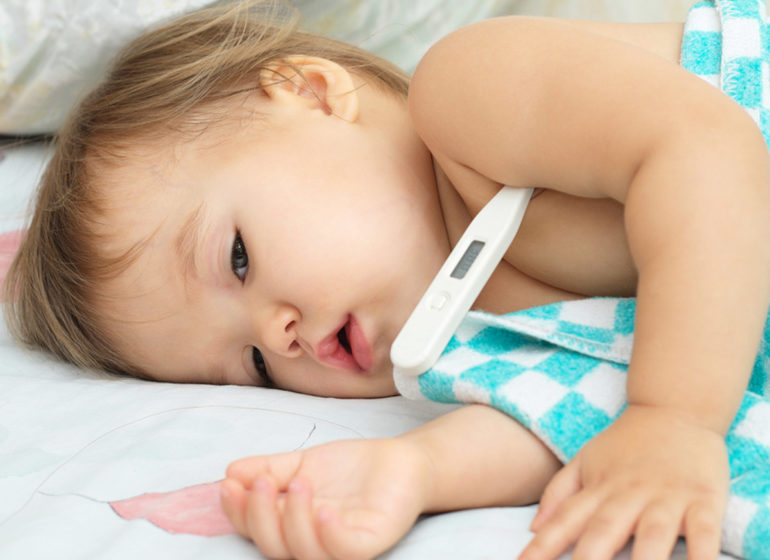
Convulsions in children: what to do without panicking
When you witness your child’s convulsions for the first time, it is easy to get caught up in a feeling of panic and not know how to react and behave
In reality, however, in most cases this is not a serious or risky condition for the child, but one that one must know how to recognise and manage without ever underestimating it because it should certainly not be denied that, in some circumstances, these seizures are associated with more serious conditions than just a symptom.
What are convulsions?
If we had to explain convulsions in simple words, we would have to define them as an involuntary contraction of muscles due to abnormal activity of certain cells in the brain.
So the child shows a contracture of the muscles and other signs that allow them to be detected.
Convulsions can mostly be seen during febrile states, but also in their absence, and then the situation can be more worrying.
Many parents mistakenly believe that high fever causes convulsions, which is false.
It is the changes in body temperature that momentarily send the brain cells involved in the process into a tailspin.
One should therefore not be alarmed if the child has a high fever by trying to lower it at all costs if he or she has shown no predisposition to convulsions.
If, on the other hand, episodes have already occurred, it is better to follow the doctor’s advice if he recommends administering antipyretics before 38°.
In the case of convulsions in the absence of fever, an epileptic seizure can be assumed.
Medical intervention is absolutely necessary.
One must not panic and a paediatrician must be called immediately.
How to recognise febrile convulsions
Distinguishing febrile convulsions from epileptic seizures is not difficult if you know the main symptoms.
Let’s look at them:
- Loss of consciousness, followed by a symptom that makes some impression: the eyes are turned upwards, here the parents become very impressed.
- Tonic phase: stiffening of the muscles, jaw clenching, stiffening of the limbs. Lasts a few seconds to a few minutes.
- Clonic phase: characterised by rhythmically cadenced muscle tremors, usually lasts a few minutes.
- Post-critical phase: this phase is characterised by a state of severe drowsiness, urine may also be lost during sleep-wakefulness. It can last up to a few hours.
In addition to these symptoms, it should be noted that febrile convulsions occur in early childhood, up to about 5 years of age.
CHILD HEALTH: LEARN MORE ABOUT MEDICHILD BY VISITING THE BOOTH AT EMERGENCY EXPO
Cause of convulsions
Here, too, it is necessary to distinguish which type of convulsion we are talking about.
If we are talking about febrile convulsions, as mentioned earlier, they are caused by abnormalities in the functioning of brain cells, often due to immaturity of these nerve cells, as the child grows up the problem disappears completely without leaving any consequences.
If convulsions, on the other hand, are not related to febrile states, investigations should be carried out, the cause could be neurological in nature, such as epilepsy.
What to do and what not to do in case of convulsions
Regardless of the type of seizure, one should never, ever try to pull the child’s tongue out or put potentially dangerous objects in the mouth, you can injure the child and those who are trying to help him.
See what to do instead:
Lay the head to one side so that the tongue does not obstruct breathing (the child also breathes through the nose), also it is common for children in convulsions to vomit, so if placed with the head to one side it will be easier to expel the regurgitation.
If this is not the first convulsive episode, the paediatrician may have recommended a diazepam-based rectal microclimate to relax the muscles. Not to be practised unless prescribed by a doctor.
Lower the fever, but not abruptly. No ice packs and no alcohol rubs, better to administer an antipyretic and leave the child uncovered.
Usually these episodes recede fairly quickly, however, it is always a good idea to call a paediatric specialist who can visit the home and assess the child’s condition.
Read Also
Emergency Live Even More…Live: Download The New Free App Of Your Newspaper For IOS And Android
Seizures In The Neonate: An Emergency That Needs To Be Addressed
Epileptic Aura: The Phase Before A Seizure
Epileptic Seizures: How To Recognise Them And What To Do
Epilepsy Surgery: Routes To Remove Or Isolate Brain Areas Responsible For Seizures
European Resuscitation Council (ERC), The 2021 Guidelines: BLS – Basic Life Support
Pre-Hospital Seizure Management In Paediatric Patients: Guidelines Using GRADE Methodology / PDF
New Epilepsy Warning Device Could Save Thousands Of Lives
Understanding Seizures And Epilepsy
First Aid And Epilepsy: How To Recognise A Seizure And Help A Patient
Childhood Epilepsy: How To Deal With Your Child?
Spinal Immobilisation Of The Patient: When Should The Spine Board Be Put Aside?
First Aid And Medical Intervention In Epileptic Seizures: Convulsive Emergencies
Airway Management After A Road Accident: An Overview
Ambulance: Common Causes Of EMS Equipment Failures — And How To Avoid Them
Seizures In Children: Types, Causes And Treatments Of Seizures


